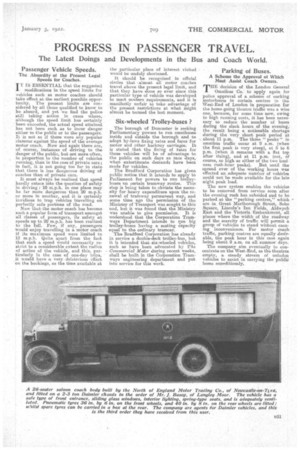PROGRESS IN PASSENGER TRAVEL.
Page 21

If you've noticed an error in this article please click here to report it so we can fix it.
The Latest Doings and Developments in the Bus and Coach World.
Passenger Vehicle Speeds.
The Absurdity of the Present Legal Speeds for Coaches.
T T IS ESSENTIAL that the suggested
1 modifications in the speed limits for vehicles such as motor coaches should take effect at the earliest possible opportunity. The present limits are considered by all those qualified to know to be absurd, and yet we find the police still taking action in cases where, although the speed limit has certainly been exceeded, the actual speed attained. has not been such as to incur danger either to the public or to the passengers. It is not as if there were any popular clamour against the speed of the average motor coach. Now and again there are, of course, instances of driving to the danger of the public, but not more often, in proportion to the number of vehicles running, than in the case of private cars; in fact., it is not going too far to state that there is less dangerous driving of coaches than of private cars.
It must always be realized that speed hardly enters into the. question of safety in driving : 10 m.p.h. in one place may be far more dangerous than 20 m.p.h. or more in another, and it is certainly invidious to trap Vehicles travelling on perfectly safe portions of the road.
Now that the motor coach has become such a popular form of transport amongst all classes of passengers, its safety at speeds up to 20 m.p.h. has been realized to the lull. Few, if any, passengers would enjoy travelling in a motor coach if its maximum speed were limited to 12 m.p.h. Quite apart from the fact that such a speed would necessarily restrict to a considerable extent the radius of action of the vehicle, and this, particularly in the case of one-day trios, it would have ,a very deleterious effect on the bookings, as the time available at the particular place of interest visited would be unduly shortened, It should be recognized in official circles that 'almost all motor coaches travel above the present legal limit, and that they have done so ever since this particular type of vehicle was developed to meet modern requirements, and it is manifestly unfair to take advantage of the present restrictions at what might almost be termed the last moment.
Six-wheeled Trolley-buses ?
The borough of Doncaster is seeking Parliamentary powers to run omnibuses inside and outside the borough and to adopt by-laws fixing rates and fares for motor and other hackney carriages. It is stated that the fixing of rates for these vehicles will be of advantage to the public on such days as race days, when extortionate demands have been made for vehicles.
The Bradford Corporation ha a given public notice that it intends to apply to Parliament for powers to run trolleybuses on pertain tramway routes. This step is being taken to obviate the necessity for heavy expenditure upon the renewal of tramway permanent way, and some time ago the permission of the :Ministry of Transport was sought to this end, but it was found that the Ministry was unable to give permission. It is understood that the Corporation Tramways Department intends to rjan big trolley-buses having a seating capacity equal to the ordinary tramcar.
The Bradford Corporation has already in service a double-deck trolley-bust but it is intended that six-wheeled vehicles, such as have been advocated by The Commercial Motor during recent weeks, shall be built in the Corporation Tramways engineering department and put into service for this work.
Parking of Buses.
A Scheme the Approval of Which Must Assist Coach Owners.
THE decision of the London General Omnibus Co. to apply again for police approval of a scheme of oarking motorbuses in certain centres in the West-End of London in preparation for the home-going theatre traffic was a wise one, because for some time now, owing to high running costs, it has been necessary to reduce the number of buses during the slack hours of the evening, the result being a noticeable shortage during the very short peak period at about 11 p.m. The three " peaks " in omnibus traffic occur at 9 a.m. (when the first peak is very steep), at 5 to 6 p.m. (when it remains with a flat top after rising), and at 11 p.m. (not, of course, so high as either of the two busi
ness rush-hour peaks). But until the spread over of the working hours was effected an adequate nuither of vehicles could not be made available for the late night peak load.
The new system enables the vehicles to be removed from service soon after the evening rush has subsided and to be parked at the "parking centres," which • are in Great Marlborough Street, Soho Square, Lincoln's Inn Fields, Aldwych East and the Victoria Embankment, all places where the width of the roadway and the scarcity of traffic will permit a group of vehicles to stand without causing inconvenience. For motor coach traffic, parking centres are equally desirable, the peak hour in this case again being about 9.a.m. on all summer days.
The company aim eventually to concentrate on the West-End, as the theatres empty, a steady stream of unladen vehicles to assist in carrying the publie home expeditiously.




























